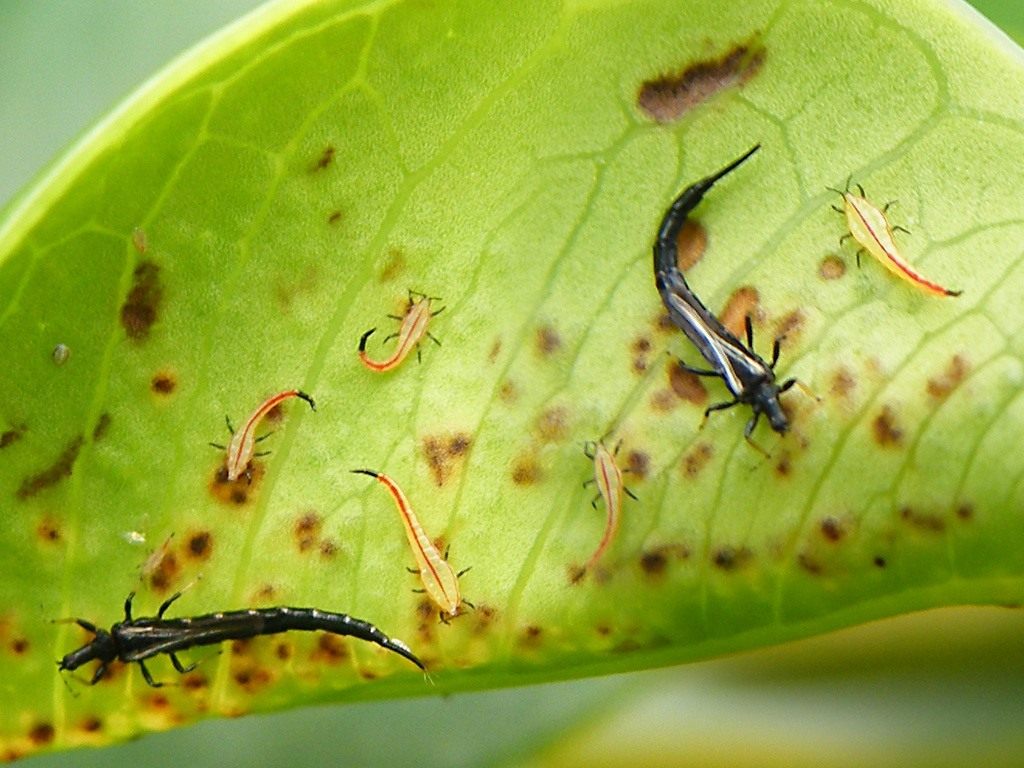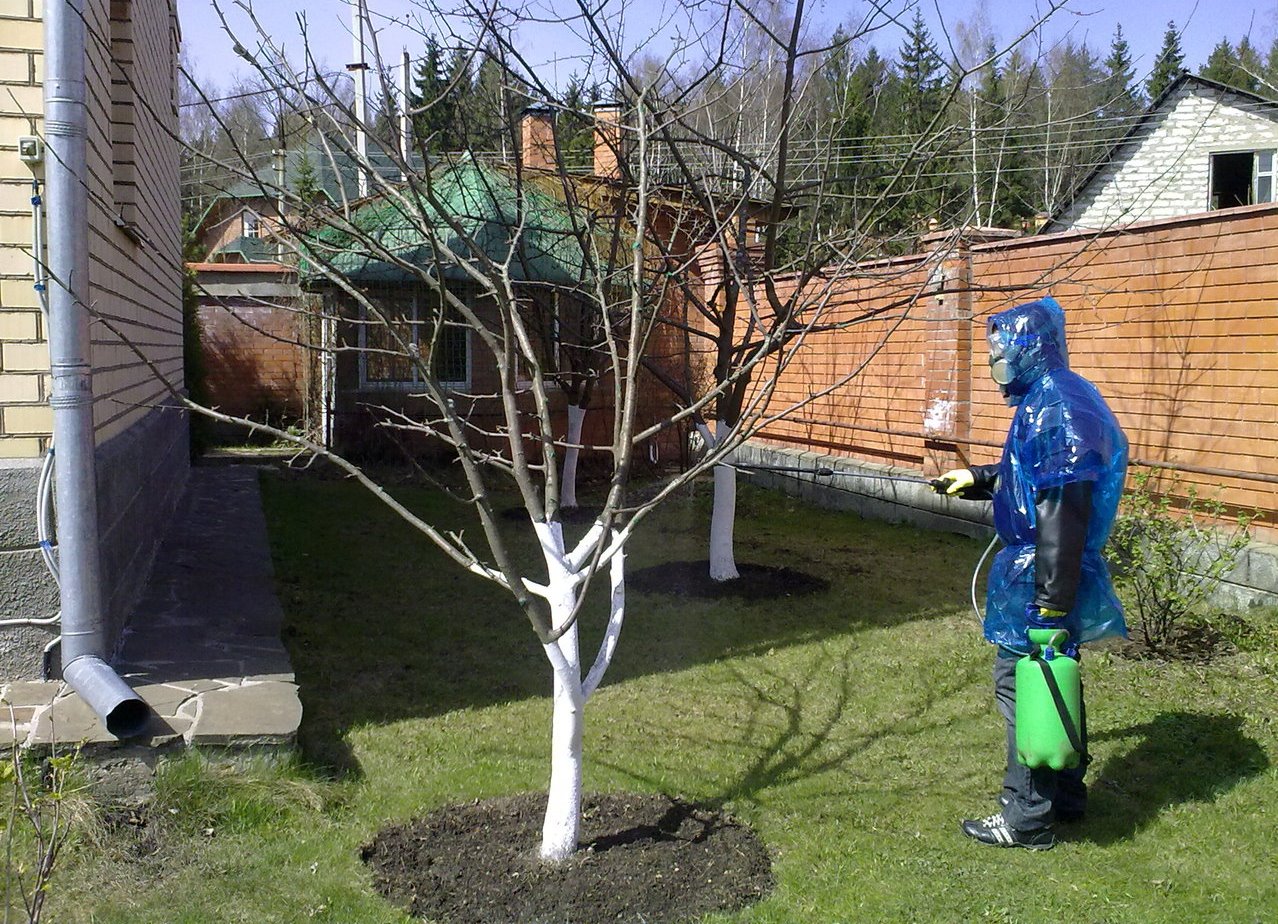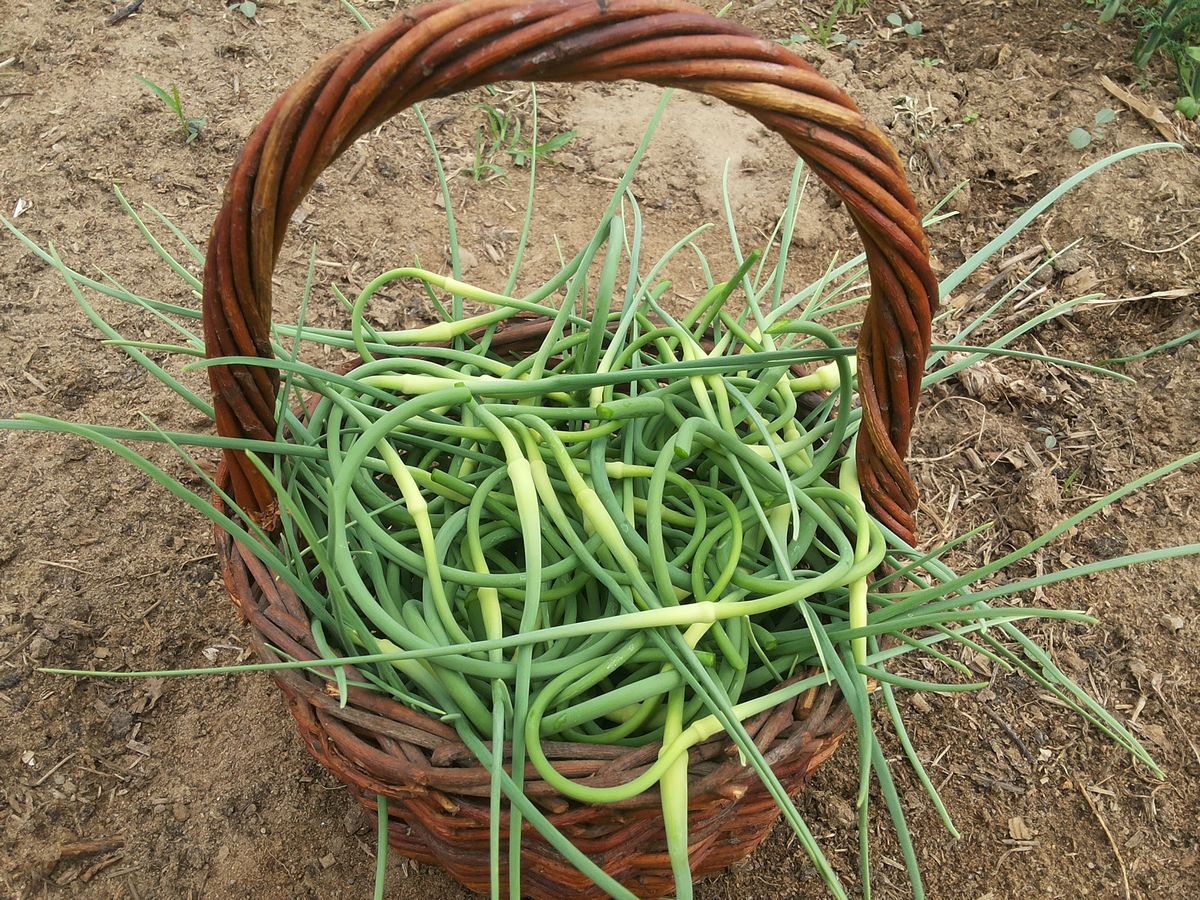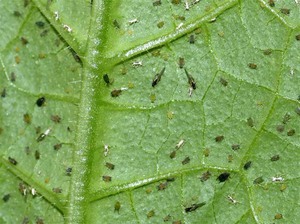 Thrips are small insect pests that are no more than 1 mm in size. The optimum temperature for the activity of thrips is + 21-29C, when it drops below + 11C, they completely lose activity. Despite the fact that these insects have wings, thrips are practically motionless. The larvae of these beetles are almost the same size as the adults, but they are lighter and without wings.
Thrips are small insect pests that are no more than 1 mm in size. The optimum temperature for the activity of thrips is + 21-29C, when it drops below + 11C, they completely lose activity. Despite the fact that these insects have wings, thrips are practically motionless. The larvae of these beetles are almost the same size as the adults, but they are lighter and without wings.
Content
Harm from thrips
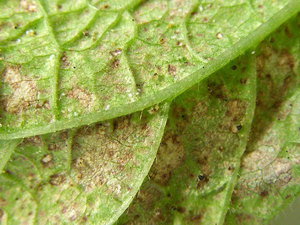 These pests pierce leaf cells, inflorescences, flower petals and suck the juice out of them. In places where thrips have already been, voids appear in the leaves, which makes their surface shiny and silvery. After a while, sooty or other bugs penetrate into the empty places of the leaves. Leaves infected with thrips no longer take part in photosynthesis, and after a short time dry up.
These pests pierce leaf cells, inflorescences, flower petals and suck the juice out of them. In places where thrips have already been, voids appear in the leaves, which makes their surface shiny and silvery. After a while, sooty or other bugs penetrate into the empty places of the leaves. Leaves infected with thrips no longer take part in photosynthesis, and after a short time dry up.
Certain species of thrips live on flowers and buds, feeding on the sap of the petals of open flowers. Why the buds get an ugly look, fall off without opening, and even if they open, then this flower will already be completely non-decorative. In addition, insects are carriers of a number of viral diseases, for example, the curl or ring spot virus.
In the case when the attack of thrips is directed at the already opened flowers of the bushes, the petals of the bud are covered with scratches, brownish-yellow spots, dry quickly, the inflorescences wither ahead of time, the flowers quickly fall off. Most of these pests flowers with white buds suffer... Almost all garden plants suffer from thrips.
Of the indoor flowers, the following plants are most exposed to these pests:
- amaryllis;
- anthurium;
- ficus Benjamin;
- begonia;
- rubbery ficus;
- orchids;
- variegated ficus;
- collision;
- blue passionflower;
- dieffenbachia;
- bell;
- fuchsia;
- chrysanthemum;
- palm trees;
- cineraria;
- monstera;
- cyclamen.
When thrips attack leaves, they are very can easily be confused with spider mites, since in both cases the leaves are silvery.
But, unlike ticks, thrips do not create a cobweb between foliage. A clear sign of the presence of thrips is the presence of crumbling pollen from pistils on flower petals or on the foliage of a bush. However, pollen also falls off during hot weather, gusty winds, during transportation, or just passed nearby, touched a bush. Carefully looking at the flower buds and petals, you can see yellow blotches or scratches, their presence significantly reduces decorativeness.
In order to make sure that pests are on the flowers, you need to pick a couple of buds and shake them over clean paper.
It is quite difficult to identify exactly which species of thrips is in your gardens and apartments, due to their small size and fast species variability. The most common pests are:
- American floral;
- western floral;
- dracaena;
- rosy;
- bulbous;
- tobacco and a number of other types.
Types of thrips
California thrips
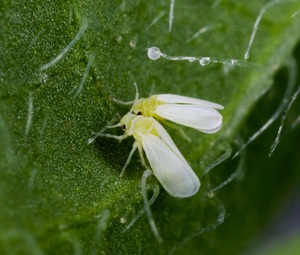 The adult is approximately 2 mm in size and can range in color from bright yellow to gray-yellow. This type of insect prefers to be on flowers and buds, but the pest is likely to multiply on the leaves. These thrips are most dangerous because are considered carriers of the tomato viruswhich gives the tomato petals a bronze color.
The adult is approximately 2 mm in size and can range in color from bright yellow to gray-yellow. This type of insect prefers to be on flowers and buds, but the pest is likely to multiply on the leaves. These thrips are most dangerous because are considered carriers of the tomato viruswhich gives the tomato petals a bronze color.
The California thrips is a fairly large polyphage. This bug can be found on cucumbers, peppers, tomatoes, onions, apricots, grapes, strawberries and some other vegetable and fruit crops, as well as on various floral and decorative flowers: roses, bells, gerberas, tulips, chrysanthemums, chamomiles, cyclamens, cineraria , Saintpaulia.
Adult species and larvae of this pest feed on the cell sap of flowers. This first creates the formation of yellow veins on berries, leaves or buds, streakiness; over time, at these sites of infection, plant cells die. The defeat of flower buds in vegetable and fruit plants creates deformation of flowers and berries.
For example, significant curly inflorescences and curl ripening tomato fruit is the first sign that this insect is on the bush. On chrysanthemums in the presence of California thrips, the infected buds do not open and die.
Tobacco thrips
This pest reaches a size of up to 1.4 mm, has a bright brown or pure brown color. The larvae can be light brown, yellow, or white.
The insect infects more than 450 varieties of cultivated plantations. This number includes both ornamental and vegetable plants. Most of all, this type of thrips harms garlic, eggplants, onions, tomatoes, cucumbers, melons - melons, watermelons, pumpkins, less often parsley, cabbage, radishes, turnips.
American thrips
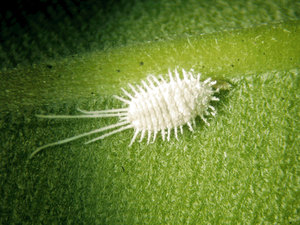 A beetle of brown or dark brown color, ranging in size from 1.4 mm (male) to 1.9 mm (female). This type of insect prefers to be found most often on the leaves, where the larvae are left in the tissues of the females.
A beetle of brown or dark brown color, ranging in size from 1.4 mm (male) to 1.9 mm (female). This type of insect prefers to be found most often on the leaves, where the larvae are left in the tissues of the females.
This variety of thrips was identified in the 80s. last century in Holland at the most popular flower exhibition, where plants from all over the world are displayed. First, the insect was found on chrysanthemums. Today this bug is transported around the world on cut flowers, shoots, potted houseplants.
Thrips activity is noticeable at first by the formation of yellow spots... The presence of already ten thrips on one bush is already enough for the flower to wilted. 40-50 bugs can lead to drying and leaf fall, which occurs from the lower tier. And although this species does not directly lead to the death of the bush, the pests significantly reduce the decorative effect of plants. In search of food, insects move to flowers and berries or to nearby plants, and in this place they already begin their vital activity.
Since the population of this species of thrips is spreading rather quickly, there is a high probability of its presence both on all ornamental and flower bushes, and on other vegetable plants that are grown in greenhouses and hotbeds.
Black thrips
Adults can reach a length of approximately 1.2-1.6 mm, dark brown or almost black in color with a dark brown belly and yellow wings. The larvae are yellow or white, in contrast to adult insects, they are slightly shorter and lack wings.
Larvae and adults of this pest are usually found on the back of the leaves. The degree of flower damage is almost the same as that of the tobacco species.
On closed ground (in greenhouses, greenhouses), black thrips is found everywhere and can reproduce all year round.Harm is caused by both adults and their larvae, causing the greatest damage to cucumbers, tomatoes, and other vegetable and fruit plants, as well as decorative and potted flowers, especially chrysanthemums. Black thrips do an excellent job of tolerating frost in the top layer of soil in compost pits or under debris.
Dracaena thrips
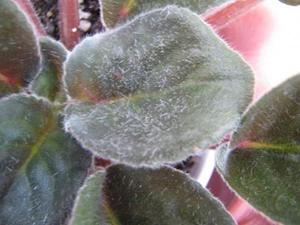 Adult bugs can be up to 1.5 mm in size, females are brown-yellow in color, males are slightly smaller and lighter in color. The larvae are white.
Adult bugs can be up to 1.5 mm in size, females are brown-yellow in color, males are slightly smaller and lighter in color. The larvae are white.
This type of insect is also a large polyphage and comes across on the foliage of a fairly large number of varieties of decorative flowers: monsters, orchids, tradescantia, aralias, hibiscus, chrysanthemums, anthuriums, dracenas, ficuses, palms, and so on. In its natural environment, dracaena thrips most often lives in subtropical and tropical climates. In the northern regions, it is more common on bushes in greenhouses and hotbeds.
In the production greenhouse conditions of thrips almost impossible to destroy completely... In the best case, their quantity is kept at a level that would not affect the commercial properties of the products. This is because pests have a fairly good adaptation to poisons and chemicals. Moreover, this applies to insects that feed on flowers.
How to deal with thrips?
Maintain high air humidity at all times. This method can be used at any time of the year. This option is an excellent protection and prevention from insects.
At home, when there is a possibility, it is advisable to remove flowers infected with thrips from healthy ones. Transfer flowers as carefully as possible: when shaking, the larvae of insects easily fall off the buds and leaves, and can wait a long time for the moment in order to settle again on the bushes.
The place where the flowers infected with thrips were located must be thoroughly washed. For infested potted flowers, it is also best to remove the topsoil as there may be bug larvae.
When processing, it is best to remove all inflorescences and infected leaves on the bushes. 3-4 treatments are required with a time interval of 9-12 days.
In the process of processing indoor flowers from insects, you can use a large package. Place the flower pot in it, spray and cover well with a bag for several hours. This method is also suitable for removing spider mites.
The only way to kill thrips is do several sprays with systemic insecticides, for example, actellik or phytoverm (these are the safest preparations for indoor use). On open ground, you can choose aktara, agravertin, vertimek, mospilan, spark, while solutions of these funds can be used both for spraying and for watering under the root. A combination of strong concentrations, with a small addition of flea shampoo, is quite effective.
In the fight against this pest, the drug Spintor, which is an insecticide of natural origin, showed itself perfectly. Spraying with a spinor occurs clearly according to the instructions with a time interval of 9-12 days.
Folk ways to remove thrips with chrysanthemums
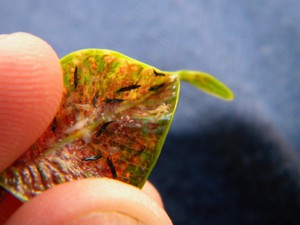 Aqueous mixtures based on:
Aqueous mixtures based on:
Barkhattsev:
- the stem of the plant and flowers (maybe a little sluggish) are placed in a container up to half the container;
- then add warm water;
- withstand the solution for 2 days, drain the water and use for spraying.
Tomato tops:
- dried foliage (about 45 grams) is poured with water at room temperature;
- let it brew for about 4 hours;
- the strained liquid is diluted with 1 liter. fresh water and use a spray solution.
Celandine:
- several bunches of fresh celandine are diluted with 1 liter. water;
- let it brew for 1 day;
- after that the mixture is ready for use.
Thrips can reproduce quite quickly.Therefore, seeing that the foliage of the bushes has begun to become covered with yellow spots, and the flowers are "strewn" with faded blotches of transparent fabric and holes with a dark outline, you need to immediately react. When handling chrysanthemums and other plants, also use manual pest picking.
